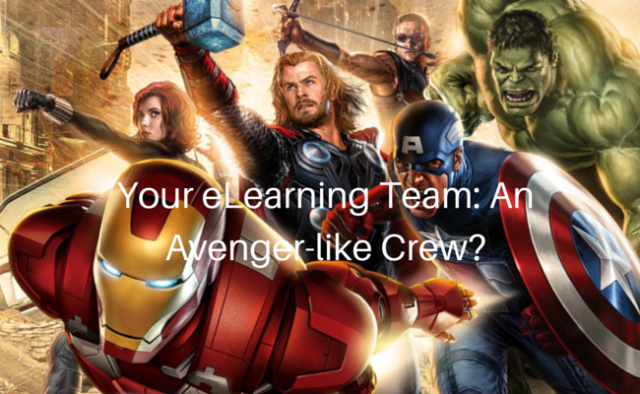
In the recently released Avengers: Age of Ultron, a team of superheroes comes together to save the world (and dominate the box office.) Each member of the team has a unique strength that makes this group unstoppable.
Really, when you think about it, the team behind an eLearning course acts much in the same way. Each person has a unique skill set that they bring to the table—and when it all comes together—the result is an eLearning course that makes a lasting impact on learners.
Do they save the world? Not exactly—but it depends on how you look at it.
In this post, we’ll look at all of the eLearning team members that work together to bring a course to life (as well as their strengths and superpowers.)
Project Manager (Captain America)
Much like Captain America, the Project Manager acts as the leader of the group. This person heads up the team and drives them forward throughout the process (even when the going gets tough.)
The Project Manager (PM) can reside within a variety of different departments. Sometimes the PM is assigned from a dedicated project management group, sometimes he or she is in the Education/Training Department, and sometimes the PM is outsourced. Regardless of where that title falls, each person on the project has some management responsibilities.
Subject Matter Expert (Black Widow)
We can’t all be experts at everything—and that’s where the Subject Matter Expert (SME) or Content Expert comes in. Like the Black Window, this person’s skills are highly specialized and can include complex maneuvers and feats that involve expert training. This person can create or provide existing content for your eLearning course, provide critical review feedback, and help write quiz questions.
Instructional Designer (Iron Man)
The Instructional Designer (ID) helps gather information from the SME and other experts, determines the appropriate scope and sequence in which to present the content, and creates instructional design documents and storyboards. Like Tony Stark, the ID understands how to use technology and advanced tools to create something truly impressive.
Other duties might include providing input on the creative treatment, preparing audio and video scripts, writing test questions, and more. The Instructional Designer typically wears many different hats and is sometimes expected to be the designer, graphic artist, and developer on the project.
Production Specialists (Thor)
These team members have specialized skills needed to bring the content to life. And much like Thor, they can summon different elements to create the perfect storm (of content.)
Since some clients want or need to visualize the course prior to the production phase, this team may be involved in creating inspiration boards, mock-ups, or prototypes. Otherwise, there is a risk that the client may not like what they ‘see’ and want to start over even though the content is accurate and the instructional design meets the learning needs. Production specialists include:
Graphic designers. Provide color scheme and branding guidelines, create user interface wireframes and layout templates, and provide graphics for the course.
Videographers (can be internal or outsourced). Coordinate video shoots or edit videos to repurpose.
Photographers. Locate and purchase the necessary stock photography, coordinate photo shoots, and work with the client or ID to incorporate graphics.
Voice Talent. Coordinate with professional voice talent or employees to record the audio portion of the course.
Developers/Authors (Hulk)
The Developers (authors or programmers) are the ones who write the programming code, input content into eLearning authoring tools, create interactions and activities, insert all assets, and then publish the course.
Like Bruce Banner (in his un-Hulk state), developers are great with complex systems and concepts, and (like Hulk), they have to be resistant to personal injury and can’t take offense when multiple rounds of revisions need made.
LMS Administrators/IT Support (Hawkeye)
Similar to Hawkeye, these team members are at the peak of their game and can handle any situation or emergency with agility.
Typically this is the client’s internal resources but might require help from the LMS manufacturer. If bandwidth or browser issues arise, these specialists step in to help. They also provide LMS settings and guidelines, define the file directory and file management protocols, and act as an internal resource for any technical troubleshooting.
The Perfect eLearning Team
It takes a whole team working together to create a great eLearning course that’s truly effective. Like the Avengers, they all have their own niche of expertise—but he final product they produce is earth-shatteringly good.
